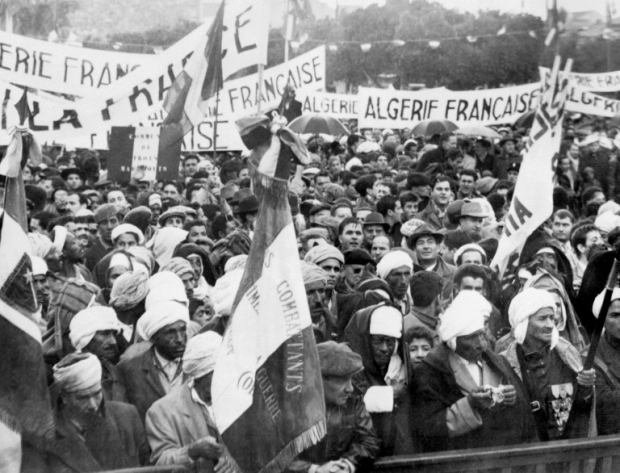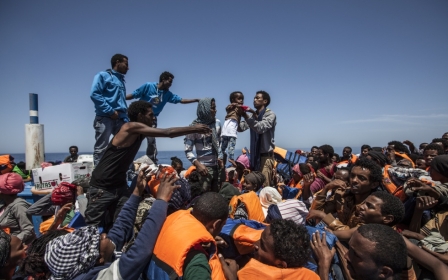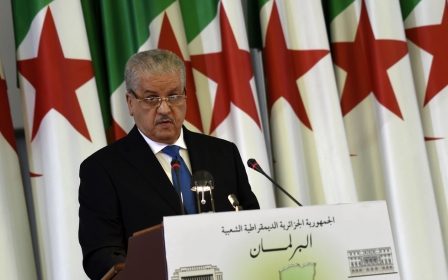
Algeria's independence: The forgotten protests that forged a nation
On 11 December 1960, three years after the Battle of Algiers, large-scale popular uprisings overcame French military oppression and changed the course of the Algerian revolution.
Since National Liberation Front (FLN) organisations in the cities and the resistance network of the National Liberation Army (ALN) had largely been dismantled by the French army, it was down to the anonymous masses of ordinary Algerians to take on the colonial order.
The colonised population, including the elderly and a vanguard of women and children from thousands of "bidonvilles" (shanty towns) and segregated quarters, converged on colonial cities throughout Algeria, with flags, banners and fists raised in the air.
Reprisals, as usual, were brutal - but they did not succeed in quelling the insurgency.
De Gaulle and the 'French Algeria' opposition
The French president Charles de Gaulle had planned to be in Algeria from 9 to 12 December to rally support for his neo-colonial "third way" solution for a transition to an "Algerian Algeria".
Based on the models imposed in other former French colonies, the plan would hand power to a ruling class, itself subservient to the French government, which would then oversee what amounted to another form of economic vassalage.
De Gaulle also intended to sound out opinion from both his troops and the "pieds-noirs," those Christian and Jews who migrated to Algeria. But intsead his Algerian transition plan unleashed the wrath of a group of hard-liners from the French Algerian Front (FAF), known as the "ultras".
Backed by a number of military regiments - and by groups within the police, government, industry, and even elite political circles - the FAF extremists hoped to repeat the May 1958 military putsch that had brought de Gaulle to power in the first place and marked the start of the Fifth Republic, the very regime it now wanted to topple in the name of "French Algeria".
In response, the FAF distributed leaflets calling for demonstrations and a general strike. The various factions were well aware that the upcoming struggle would determine the laws and shape of either Algerian independence - or apartheid. And while a show of force from European hardliners was pretty much expected, no one foresaw the popular Algerian insurgency.
No more abuse from the 'ultras'
On 10 December, the first uprisings broke out on the Rue de Stora (now Rue des Frères Chemloul) in Oran, and the Rue de Lyon (now Belouizdad) in Algiers. Here is also where the first ranks of impromptu protests formed, as unrest emerged in urban areas on the periphery of colonial segregation.
Mostepha Hadj, a resistance fighter from Oran, explained:
"As soon as the alarm was sounded, all of the inhabitants of Medina Jedida went into self-defence mode, chanting 'Allahu Akbar', encouraged by the deafening ululations of the women stationed on terraces and balconies who had stockpiled all sorts of projectiles – bottles, sticks, stones, tiles – ready for anything. … The Algerians from other quarters answered the call with incredible spontaneity."
The army and the police used loudspeakers to order the insurgents to return to their neighbourhoods. Meanwhile the ultras crisscrossed the streets, honking a relentless rhythm syllable by syllable: "FRENCH – AL–GE–RI–A".
Remembering Algeria 1992: The first Arab spring that never became a summer
Eventually the military and police barricades blocked several quarters, so the women and their ululations accompanied the flow of protesters, whose ranks continued to swell from all sides.
In Algiers, after initial upheavals in Belcourt, the inhabitants of Nador bidonville and other self-built shantytowns that had grown since the 1930s, rose up in protest.
By 1954, migrants from the mountain regions and from the war-torn countryside had also began pouring into the region - and it was populations like these who made up the bulk of the protesters in December 1960.
Witnesses were deeply affected by women's courage, and the sight of their haiks [traditional long white veils] stained red with blood
Lounes Ait Aoudi, a protester who still lives in the casbah, describes how ranks of women at the head of the marches rammed into military barricades where soldiers opened fire on many of them. Witnesses were deeply affected by women's courage, he recalled, and the sight of their haiks [traditional long white veils] stained red with blood.
In a single afternoon, the "Belcourt flame" spread first to the working-class areas on the outskirts of Algiers and then, in the days that followed, to Constantine, Annaba, Sidi Bel Abbes, Chlef, Bone, Blida, Bejaia, Tipasa and Tlemcen.
For nearly a week, spontaneous uprisings were met with methods of ruthless repression by the government and the ultras.
The end of the Gaullist 'third way'
The December demonstrations eventually forced de Gaulle to give up on his "third way" solution and send the ultras back to the conspiracy drawing board.
To recover political legitimacy, groups related to the FAF claimed that the demonstrations had emerged from an Urban Administrative Section (SAU) psychological campaign.
They alleged that this attempt at manipulation had ultimately turned into an outbreak of "anti-European racism".
Military sources, the FLN and civilian witnesses confirmed that certain members of the Specialised Administrative Services (SAS) - a body seen as a response to the under-administration of large parts of Algeria - had approved the spontaneous demonstrations, believing that Gaullist slogans such as "Algerian Algeria against the Ultras" could be imposed.
Some dissenters did, at times, shout such slogans to get past security forces and their barricades. Their intention was to join demonstrations in support of independence and against the neo-colonial plan, just as had happened in the majority of cities where the SAU had not intervened.
Formal and informal FLN networks, each with only a few dozen militants, began to spring up in major cities. Algerian historian Daho Djerbal said that the FLN "never abandoned the principle of being a people's organisation".
That said, the activist networks were in no way comparable to those of the structured hierarchies of the ZAA. Rather, grassroots militants were engaged in collective and autonomous forms of popular organisation. A few "official party activists" (very much a minority) attempted to set the tone of the demonstrations by promoting anti "Algerian Algeria" slogans – which could be seen as support for the Gaullist neo-colonial plan – and distributing banners, tracts and slogans for "Muslim Algeria".
Dreams of independence
The slogans that flourished in a number of cities, including "Negotiations with the FLN now," "Abbas for president" and "Long live the GPRA," made quite an impression on international observers and were even debated on the floor of the United Nations.
I interviewed Bahiya, the daughter of an FLN fundraiser from Belcourt, who participated in the demonstrations when she was 10. She said:
"At one point we realised we were on our way to independence. My sister had been sewing flags at home for some time. She had trained as a seamstress, so she sewed beautifully. My mother had a sewing machine. All you needed was to buy little white and green fabric, and red for the crescent. She made a lot of flags. And naturally we brought them with us that day."
Contrary to the accounts of certain FLN members during this period, Bahiya assured us that lots of women were sewing flags well before December 1960, and that nobody had encouraged them to do so or given them instructions on the evening of 10 December.
"I imagine that most women worked for the revolution incognito, by giving shelter to fighters or a few coins to the cause ... because they wanted their children to be free," she said. "There were a lot of children [in the demonstrations]. And they wanted it too, a life of freedom ..."
Meanwhile, makeshift hospitals run by Algerian doctors and nurses were set up in apartments and mosques. Outdoor cafes ensured that everyone could eat - even in the districts that were blocked off.
Troops had been deployed nearly everywhere and, with the consent of the political ruling class, they had fired and killed, raided and tortured
The many French and foreign journalists covering the events were approached by teenagers, even children, and taken to what was described as "FLN headquarters," to hear the opinions of pro-independence factions.
A constant thread runs throughout all of these events; that of the determined involvement of women, children and the elderly and, more generally, of civilians hitherto regarded by French military and politicians and certain divisions of the FLN/ALN, as mere "populations to be conquered".
The people's independence wrested from colonial domination
A majority of the French army subsequently maintained that the government was overpowered because it had refused to commit to an armed intervention to suppress the counter-insurgency. Yet troops had been deployed nearly everywhere and, with the consent of the political ruling class, they had fired and killed, raided and tortured.
The fact is, the police actions in December 1960 were not checked by the Gaullist government and were only stymied by the scale of the Algerian uprisings. According to historian Gilbert Meynier, the French authorities officially recognised 120 deaths, including 112 Algerians and hundreds of wounded. Dozens of the insurgents, including teenagers, were arrested and "interrogated": in the weeks that followed, some would "disappear" for good.
Algerian women were at the forefront of the protests, where they were also pulling the strings backstage in organising the impromptu uprisings
The events in Algeria strongly influenced the implementation of repressive measures later taken in Paris by the prefect of police, Maurice Papon, a former "special operations secretary general in Algeria".
On 17 October 1961, thousands of Algerians of all ages, from bidonvilles and working-class areas of Paris, who had gathered to protest colonial rule and racism, were rounded up, beaten and interned. Several dozen were eventually killed that night by police in the centre of the city.
After the uprisings, the military loosened their stronghold over the mountain regions. De Gaulle ordered a halt to all executions, abandoned his plans for the “third way” and resolved to negotiate with the provisional government of the Republic of Algeria (GPRA) under Ferhat Abbas and Krim Belkacem.
On 19 December, the General Assembly of the United Nations unanimously passed resolution 1573 (XV), recognising the Algerian people's right to "self-determination and independence".
After 130 years of subjugation and five years of brutal warfare, the Algerian people had taken charge of the revolution.
New ruling classes have since re-established forms of subservience supporting neo-colonial pursuits, but the story of the popular uprisings of December 1960 - much of which remains to be explored - tells of the efforts and determination of an oppressed people who took back their independence from colonial powers.
- Mathieu Rigouste is an independent researcher in social sciences and the author of The Enemy Within: A Colonial and Military Genealogy of Security Directives in Contemporary France (La Decouverte, 2009). He is currently researching the events of 11 December 1960. His project called The Only Hero, the People is an independent investigation of the Algerian demonstrations of 11 December 1960 that will be published in book, documentary film and website form. For more information on the project, click here.
Photo: Thousands of Algerians descend into the European districts of Algiers protesting in support of the FLN against French colonial rule on 11 December 1960 (AFP)
This article was published by Middle East Eye in collaboration with Orient XXI. Translated from the French by Heather Allen.
Middle East Eye propose une couverture et une analyse indépendantes et incomparables du Moyen-Orient, de l’Afrique du Nord et d’autres régions du monde. Pour en savoir plus sur la reprise de ce contenu et les frais qui s’appliquent, veuillez remplir ce formulaire [en anglais]. Pour en savoir plus sur MEE, cliquez ici [en anglais].








